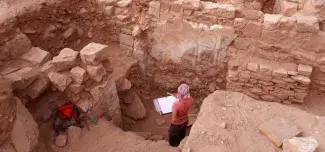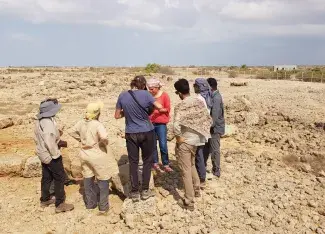
Researcher profile : Pauline Piraud-Fournet
Pauline Piraud-Fournet, co-director with Abdullah Basonbol of the Hegra Archaeological Project (HAP), hosted by the Jaussen & Savignac programme: PROFILE
Pauline Piraud-Fournet, a qualified architect and PhD in archaeology, is leading the Hegra Archaeological Project in Saudi Arabia, with Abdullah Basonbol, succeeding Leïla Nehmé (CNRS).
This archaeological mission is hosted by the Jaussen & Savignac Archaeological Research Center and supported by the Royal Commission for AlUla (RCU) and the French Agency for AlUla Development (AFALULA).
Meet this architect-archaeologist with her well-rounded profile and a career that is both rich and uncommon.
Programme J&S – Can you tell us about your rather unconventional journey?
Pauline Piraud-Fournet – Yes, of course — and I believe that talking about one’s career path is a way to share ideas and help students who are questioning their own professional projects.
Ever since I was very young, I have always been interested in archaeology. As a high school student, I took part in internships on restoration sites, and the summer I graduated from high school, I had the opportunity to join excavations at a Nabataean site in Jordan, at Dharih, within a mission directed Pr. François Villeneuve from university Paris 1 Panthéon-Sorbonne and the French Institute of the Near East. That experience was truly formative: it not only confirmed my professional choice but also gave me a wonderful opportunity to meet seasoned researchers and archaeologists, who in the following years invited me to take part in other excavations (in Beirut, Bosra, and later in other regions, including Pakistan, Tunisia, and Egypt).
In the meantime, I began my university studies in Art History at Sorbonne University (then Paris IV), while simultaneously continuing my technical training on the archaeological sites I mentioned, alongside researchers from Paris 1 Panthéon-Sorbonne and the CNRS. This dual training — in Art History and fieldwork — allowed me to discover very early the great diversity of careers in archaeology and quickly guided me toward the study of architecture. After completing my master’s degree (what is now called a Master’s In the French university system) on the transformation of pagan sanctuaries in the Near East into churches during the Proto-Byzantine period, I continued my studies by enrolling at the École Nationale Supérieure d’Architecture de Paris-Belleville in 1996, where I was able to train, among other things, in drawing. Two years later, I had the opportunity to move to Syria. I then paused my architecture studies and enrolled in a DEA programme at Paris IV, which I completed from Damascus — this corresponds to what is now a second-year Master’s (at the time, there were fewer courses, but a more substantial research component). I devoted this DEA to the architecture of Late Antiquity in Bosra. A few years later, after returning to France, I resumed my architecture studies and completed my degree. I then successfully applied for a position as an architect-archaeologist researcher at the Ifpo in Damascus. For over ten years, I was fortunate to work on numerous archaeological sites throughout Syria while also beginning a PhD on domestic architecture and urbanism in Bosra during Late Antiquity at Sorbonne University (Paris IV), under the supervision of Professor François Baratte, which I defended in 2016.
Armed with this PhD, I obtained a two-year research contract at the American Center of Oriental Research (ACOR) in Amman, Jordan, where I was responsible for analyzing forty years of 20th-century excavations at a Nabataean temple in Petra, identifying research themes to develop, and preparing the publication plan. I then secured a Marie Skłodowska-Curie Actions fellowship at Paris 1 University, within the OrAM team of ArScan-CNRS, funded by the European Commission. My new research programme aimed to highlight, through archaeology, the public welfare institutions in the Near East during Late Antiquity. This programme led to excavations and survey missions, a conference, and the publication of a book (Charity, Relief and Humanitarianism in the Middle East, by Falestin Naïli, Valentina Napolitano and Pauline Piraud-Fournet).
I like to tell students that our training in the humanities and social sciences teaches us how to conduct investigations and present our findings, and that this method can be applied to areas far beyond archaeology alone. During and after my PhD, I had the opportunity to participate in a research programme in sociology and ethnology, as well as to carry out surveys in the socio-judicial field.
Around 2022, I was able to expand my research area to Saudi Arabia, directing an archaeological mission in the Wadi Sirhan region on behalf of the Saudi Heritage Commission (HC) and Paris 1 Panthéon-Sorbonne University. So, naturally, when the Jaussen & Savignac programme was established, I applied and was accepted to co-direct the Hegra Archaeological Project (HAP)
P J&S – What a fascinating career! Are you a specialist in a particular period and geographic area?
P. P.-F. – I have worked extensively on the architecture from the Nabataean and Roman periods through Late Antiquity up to the time of the Islamic conquest, in Bosra, in the Hauran region shared between southern Syria and Jordan, and in Petra — a vast area with a quite distinctive architectural identity, whether in basalt or limestone.
This entire region was part of the Nabataean kingdom, with Damascus located at the northern edge of the kingdom at its greatest extent in the 1st century BC. By taking on the co-direction of this archaeological project in Hegra, I am delighted to reconnect with the Nabataean period that is familiar to me, while also discovering much about Saudi Arabia — particularly for earlier periods with which I had little previous experience. It is an exciting challenge for me. Moreover, being able to conduct this mission within the framework of this Franco-Saudi scientific partnership is a tremendous opportunity, as we benefit, thanks to the Royal Commission for AlUla (RCU), from advanced data collection and analysis tools (GIS, DNA, isotopic studies, etc.), and can, through university collaborations (Paris 1, King Saud University, etc.), train the next generation of archaeologists.
P J&S – Throughout your professional career, you have experienced two different university systems and worked with several academic and other institutions. How do you see the role of an architect-archaeologist evolving?
P. P.-F. – It seems to me that in recent decades, Paris 1 Panthéon-Sorbonne University has been at the forefront of developing new techniques in archaeology, particularly in landscape archaeology and emerging disciplines such as archaeozoology, archaeobotany, and many other fields, to enhance our understanding of ancient societies. These techniques are remarkable and have led to incredible discoveries: reconstructing ancient landscapes, economies, subsistence strategies, cultic and funerary practices, identifying taboos, and more.
Perhaps the downside has been the sidelining of more traditional archaeological techniques that prevailed in the 19th and 20th centuries, at a time when the main resources that could be exploited were statuary, coins, ceramics, and the more visible and often monumental architectural remains. With the advent of new technologies such as 3D scanning and photogrammetry, data is often recorded with the intention of analyzing it later. However, architecture, like other material remains, cannot do without detailed drawing and description on site, which allow information to be filtered, classified, prioritized, and analyzed. New technologies save us valuable time by quickly providing a solid foundation, from which data collection and sorting must still be carried out in the field. But of course, they cannot replace the researcher in the analytical and comparative work necessary for reconstruction.
